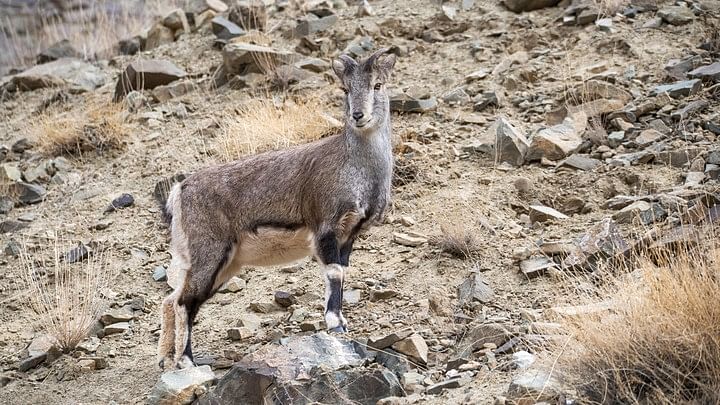
Representative image of a wild goat.
Credit: iStock Photo
Rome: Come June, a crack team of wildlife experts plans to swarm the volcanic cliffs and natural caves of a small island in the Mediterranean to ensnare what has become an out-of-control species: goats gone wild.
It is the first step in a mission to rid the Aeolian Island of Alicudi, just north of Sicily, of the hundreds of feral goats that are crowding out the island's 100 or so year-round human inhabitants, so that the animals can be adopted elsewhere.
"We are all for goats running free, but let's be clear: These aren't Heidi's kid goats," said Carolina Barnao, a council member in neighboring Lipari, which administers its fellow Aeolian islands. "Some of them could even become dangerous."
After being seized on Alicudi, the goats will be rustled down to an enclosure near the island's port, tested for diseases and then hoisted onto a ship heading to Sicily, where they will spend two months in quarantine. Then, they can be adopted and taken to greener pastures.
Yet it is not as straightforward as it sounds.
For one thing, said Giovanni Dell'Acqua, the regional government official overseeing the undertaking, the goats are fast and can leap 10 feet in a bound. They can also weigh as much as 175 pounds, he said - "think of what that means".
"And while the animals will be penned up on Alicudi for as short a time as possible," Dell'Acqua said, officials still have not quite sorted out what kind of boat to use to safely transport the goats to the mainland.
"Trust me," he said, "capturing the goats on an island like Alicudi is an uphill battle."
Measuring 2 square miles, Alicudi is the least inhabited and most remote of the seven Aeolian islands off Sicily's northern coast.
In the absence of cars and many other amenities, donkeys still hoist supplies up unpaved streets, and distances are measured in stair-steps from the port.
"The island's allure is that there is nothing there," said Pietro Lo Cascio, a zoologist and nature guide on the Aeolian islands.
The goats themselves arrived about 35 years ago, when an islander sought to supplement food supplies from the mainland.
At some point, the handful of goats got loose and were left to forage among the rugged terrain of the dormant volcano.
It did not take long for the ruminants to outnumber humans, delighting tourists by photobombing their summer memories.
But locals grew irritated as the goats encroached on their gardens and fruit trees and leaped along the traditional dry-stone walls that once terraced the island, knocking down many.
Emboldened over the years, the goats moved from the crest of the island into the lower, inhabited areas in search of ever-decreasing food supplies -- "even people's homes," said Barnao, the council member, whose mandate for animal rights includes overseeing the goat giveaway.
And although Alicudi is a nature reserve, the ballooning goat population has also put the island's biodiversity at risk.
Lo Cascio said he raised warnings about the growing goat population in 2008, when he was a member of the Lipari municipal council. At the time, he estimates, there were 200 to 300 goats on Alicudi.
Last year, a census counted 600 goats, a 6-to-1 goat-to-human ratio, but Lo Cascio suspects that it is even higher.
If action had been taken years ago, the situation "could have been resolved with a minimal effort," he said. "Today it is a catastrophe."
Yet Barnao said the adopt-a-goat program, which the regional government and local administration introduced this year via a public notice, had attracted considerably more requests for the goats than the number of animals available.
The wildlife experts will now try to catch as many goats as possible before the tourist season begins in mid-June.
Captured animals will be tagged so officials can keep tabs on "their destiny," Barnao said. If the initiative is successful, she said, it will probably be replicated on other Aeolian islands.
But not everyone thinks the goat getting is a great idea.
"They could have found less cruel solutions" than removing the goats from their familiar territory, said Lorenzo Croce of Aidaa, an animal rights group that filed a legal complaint in the hopes that local prosecutors and a regional court would stop the giveaway.
Aidaa had suggested that the goats be taken to a sanctuary in Italy for animals that have been saved from slaughter. "They have a right to die in tranquillity at the end of their natural lives," Croce said. But he said the proposal was rejected.
Mourad Rekik, an expert in small ruminants at ICARDA, an international research center, said that introducing feral goats into a domestic flock "usually happened quite smoothly".
Rekik warned that catching feral male goats could be a particular challenge - and, if the horns have developed, "a little bit risky for the people" doing the capturing. "These animals can probably defend themselves," he said.
If the goats elude capture, Dell'Acqua said, the team might have to "resort to Plan B," which is to shoot and kill them, if they receive authorization to do so.
As it is, many locals are already exercising some form of goat population control by shooting and eating them, Dell'Acqua said. "Their refrigerators are full, I can assure you," he said.